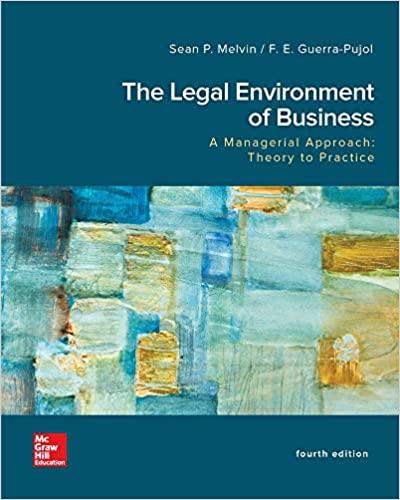Question
I don't understand how I should make case/argument for plaintiff. Facts It was a wet and nasty spring in upstate New York, and that combined
I don't understand how I should make case/argument for plaintiff.
Facts
It was a wet and nasty spring in upstate New York, and that combined with the preceding frigid winter led to potholes on every street in the city of Albany. The city government, besieged on all sides by irate homeowners and car drivers, decided to beef up their pothole fixing capacity. They hired new workers and gave them a few days of training on how to fix potholes. The city also decided to upgrade its' fleet of repair trucks.
A car manufacturer (ACME) manufactured the cab and chassis (flat-bed, wheels, axle, etc.) of a truck that was sold to Keefer Motors (KM). The truck sat on the lot of Keefer Motors for two days and then was sold unchanged to the city of Albany. Neither ACME nor KM discussed with the city what the city would do with the truck. The city then took the truck to Susan's Truck Equipment Co. (STE), a manufacturer of add on items necessary to convert generic trucks for specific uses. STE manufactured a dump bed and hoist that was sold to the city of Albany and, then installed the dump bed and hoist on the ACME truck. The modified truck was then redelivered to the City of Albany, where it was accepted and immediately put into use.
Sarah, one of the new city employees, was injured when her coworker, Emma, another new city employee, backed the pothole truck over her. Sarah is seriously injured and sued ACME, KM and STE arguing that the truck was defective and unreasonably dangerous because (1) the defendants failed to warn the purchaser, city of Albany, of the necessity of installing a back-up alarm and (2) the defendants failed to install a back-up alarm. The theories used include strict liability, negligence, breach of implied warranty of fitness and merchantability, and breach of express warranties.
Please take a look at the following document to see very important information regarding both general principles of law and a specific note regarding the law in this case.

Step by Step Solution
There are 3 Steps involved in it
Step: 1

Get Instant Access to Expert-Tailored Solutions
See step-by-step solutions with expert insights and AI powered tools for academic success
Step: 2

Step: 3

Ace Your Homework with AI
Get the answers you need in no time with our AI-driven, step-by-step assistance
Get Started


